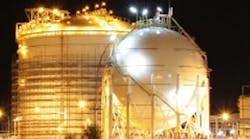Check Out Montague's Google+ profile.
Newly abundant shale gas and the continued economic recovery are just two of the many positive developments affecting the specialty chemical industry. However, engineers and their companies still need some serious know-how to fully take advantage of these opportunities with the right data, analysis and tools, and by employing them in the right settings and at just the right times.Gordon Bordelon, principal consultant for chemical industry solutions at Rockwell Automation, outlined several chemical market trends and challenges for attendees of the Specialty Chemicals Industry Forum this week at Automation Fair, presented by Rockwell Automation in Houston. Among the forces defining the automation landscape for specialty chemicals manufacturers are dwindling veteran workforces, lack of standard data infrastructures or toolsets, aging production assets and limited resources to deal with increasing performance demands.
"Some of the other changes we're seeing have been the emergence of the ISA S88 batch standards and other common programming constructs; increased computing power and drops in collection costs per point; and new or rediscovered data-driven methodologies," said Bordelon.
Concept Design Is Critical First Step
"Fluor is one of the world's largest publicly traded engineering, procurement, maintenance and project management companies in the energy, chemical, global services, government and other fields, and we usually have about 1,000 projects going on at any one time with about 600 clients in 79 countries," said John McQuary, Fluor's vice president of workflow optimization, as he took the Specialty Chemicals Industry Forum podium.
Read Also: Online Community Demonstrates Power of Industrial IP
"Big data is increasing in volume, variety and velocity." Janice Abel, of the ARC Advisory Group, on the growing need for enterprise manufacturing intelligence (EMI) applications.
"I'm mainly responsible for work process optimization and redefining our operating model," McQuary continued, "which we've distilled into 24 primary requirements that all projects must meet. What we're seeing is larger and more complex projects at the billion-dollar level, which also have more aggressive schedules and involve more complex supply chains. As a result, there's not enough engineering expertise to complete them in any one place, so many of our offices are partnering with each other more often, and we're also working more closely with our competitors to get these projects done."McQuary reported that Fluor's engineers usually begin with a concept design and then develop a detailed design before construction. "However, it's the concept design that can have the most affect on total project costs—usually up to 80% of our committed costs," explained McQuary. "This is why involving process automation at the concept design stage is such a great, low-hanging-fruit opportunity for aiding both total installed costs and lifecycle costs. Likewise, using created data assets early on in projects can help when specifying deliverables and formats. The essentials of process automation are critical to understanding all aspects of specialty chemical and other process applications, but automation planning needs analysis, goals and smart tools, too. "For example, we're also using 3D models after construction to color-code equipment and help create reports on operating assets."
"There's a lot of hype around big data, but there's also no denying that it can provide better views into operations by identifying patterns and helping to predict future performance," McQuary said. "We're also working on using embedded knowledge and synching it with augmented reality tools to give us a better perspective on what's going on in the real world to improve long-term plant performance."
Intelligence in Operation
Using the perspective of many companies and applications, Janice Abel, principal consultant in ARC Advisory Group's regulated industry division, reported that enterprise manufacturing intelligence (EMI) is high on companies' list of priorities as investment returns to specialty chemical and other process sectors.
A manufacturing execution system (MES) typically takes operating data and uses it to aid workflow and plan and further optimize performance, Abel explained. "One of the newest functions of EMI is to aggregate KPIs [key performance indicators] and other data, visualize them, conduct data analysis, create dashboards and distribute them to users for better decision-making," said Abel.
"For instance, Rockwell Software FactoryTalk VantagePoint helps integrate and contextualize many sources of specialty chemical and other process data to make it useful to operators, engineers and managers. Big data is increasing in volume, variety and velocity, making EMI applications increasingly important."
Unfortunately, one in three business leaders make decisions based on information they don't have or don't know, Abel continued. "Further, one in two say they don't have the information they need, and 60% of CEOs report they need to do a better job of capturing data to make better decisions faster," Abel said. "All data can fuel intelligence, and it's growing because there are so many sources—from many more connected field devices to websites to social media.
ARC Advisory Group cautions that none of the data is useful unless something is done with it to deliver value to the organization. Actionable intelligence is the new mantra. "As one plant manager told us, 'We're drowning in data, but starving for intelligence.' So, what he needs is at least one good KPI that he can put in context and then be able to interpret intelligently."
For example, one chemical plant reported that every 1% improvement in overall equipment effectiveness (OEE) results in about $1 million per year increased profit, while another chemical plant integrated its plant data with other technical sources across its enterprise, got information to the right users and paid for its new system in less than six months.
"One herbicide producer needed a way to retrieve data and report it easily; its track-and-trace procedures were outdated," said Abel. "So it built a new facility and implemented Rockwell Software FactoryTalk VantagePoint and its historian, metrics and batch recipe software. This resulted in faster and better decision-making; automated real-time data capture; increased data security; improved regulatory compliance; put KPIs on real-time dashboards to enable real-time decisions; and reduced labor costs, errors and non-value- added activities. It also created an integrated, scalable system that enables quality and on-demand supply and increased the overall production by 166%."
Likewise, a petrochemical firm with 5,000 employees and multiple plants processing oil sands found it had a bottleneck in data reporting, lots of added programming changes for its IT department, excessive Excel reports and customization, disparate data sources and manual data entry. To give it better data visualization and intelligence, the company also implemented Rockwell Software FactoryTalk VantagePoint at two facilities, accelerating report delivery and intelligence, all the while minimizing risk with an off-the-shelf solution, which also supports different types of reports and manual entry.
This reporting revamp took six months, and the new solution supports different report types faster, including regulatory compliance data. "This user now gets KPI indicators for facility operations on scorecards and can now distribute useful information via smart phones and deliver full reports via email," adds Abel. "Reports that used to take six or eight hours now take two or three minutes.
"The roadmap to EMI begins with vision and a culture change, including support and funding from the top," Abel said. "EMI is a high-reward, low-risk technology, but it takes the collaboration of the whole organization."
Five Ss Come Before Six Sigma
Meanwhile, Jeremy DeBenedictus, operations and engineering vice president at plastics-to-energy startup Vadxx Energy Corp. and a Six Sigma black belt formerly at GE, reported on how lean operating principles can be applied to eliminate variation from chemical manufacturing processes. This method involves using the methodology of define, measure, analyze, improve and control (DMAIC).
However, before attempting to apply Six Sigma principles, DeBenedictus recommends practicing the five Ss, which are sort, stabilize, shine, standardize and sustain, in order to provide structure. Next, he suggests gaining overview and insight by adopting Kaizen principles, such as visual KPIs and a continuous improvement culture. Finally, he advises using lean practices, such as the stabilizing process and eliminating waste. "You don't want to do Six Sigma until you've done the five Ss, Kaizen and lean, just as you don't do advanced process control until you've tuned all your process loops," says DeBenedictus. "You don't need sophisticated models to start. You can even begin with paper and pen or a whiteboard to identify key input variables and key outputs."








